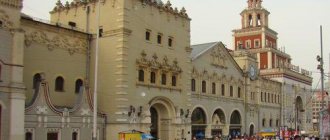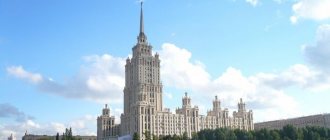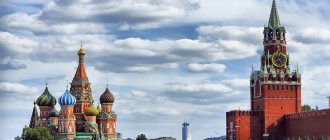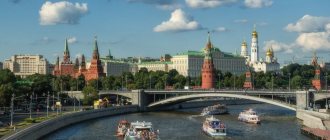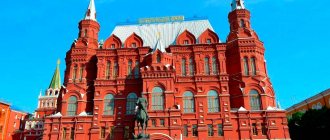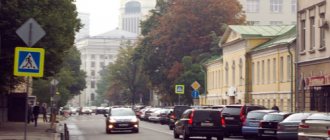Objective and subjective factors led to the fact that at the end of the 14th and beginning of the 15th century, Moscow became not only the political, but also the spiritual center of Rus'.
Klyuchevsky
The rise of Moscow is a political process that took place in the 14th and 15th centuries. This process is interesting because, as a result of the struggle between the appanage principalities, Moscow won a victory - a city that literally 100 years before was provincial, and at the time of its rise was not distinguished by either wealth or conditions. But thanks to the symbiosis of Moscow, the Horde and the church, this process became possible.
Stages of the unification of Russian lands around Moscow
The entire process of the rise of the Moscow principality and the unification of Russian lands can be reduced to 3 main stages:
- End of the 13th century - 80s of the 14th century
- 90s of the 14th century - 1462
- 1462 - 1533
The first stage - until the 80s of the 14th century
This stage is characterized by a struggle between Moscow, Tver and partly Lithuania.
The main process that took place at this time was the struggle of individual principalities of northeastern Rus' for a dominant position. As a result, Moscow managed to secure the label of the Great Reign for itself. An important point is that the Moscow prince received a label for the Great Reign, but he was called the Prince of Vladimir. Table: the first stage of the unification of Russian lands and the rise of Moscow
| Formation of the Moscow Principality | ||
| Yuri Danilovich (1303 - 1325) | Annexation of Mozhaisk (1303) and Pereyaslavl-Zalessky principality (1304) | |
| Ivan Kalita (1325 - 1340) | The beginning of the confrontation with Tver. Galich, Uglich and Beloozero were annexed. | Suppression of the anti-Horde uprising in Tver (1327) |
| Simeon the Proud (1340 - 1353) | ||
| Ivan the Red (1353 - 1359) | ||
| Dmitry Donskoy (1359 - 1389) | Annexed: the principality of Uglich, Galich, Kostroma, Starodub, Dmitrov, Kaluga. | Battle of Kulikovo (1380). Sack of Moscow by Tokhtamysh (1382) |
Confrontation with Tver
The first stage of the unification of Russian lands around Moscow is associated with the struggle between the Moscow and Tver principalities. The confrontation was serious, since in the neighborhood there were two principalities, each of which sought to become dominant in Rus', and each of which had a very good geographical position. At the same time, Tver was a more developed principality and its position was more attractive. Therefore, Moscow played a secondary role for a long time, but using their friendship with the Horde, the Moscow princes achieved their goal. Basically, the rise of Moscow at the first stage, the confrontation with Tver and the victory in this confrontation is associated with the name of Ivan Kalita.
In 1327, Cholkhan arrived in Tver to collect tribute. An anti-Horde uprising arose in Tver, as a result of which Cholkhan and all the Horde were killed. Khan Uzbek, as punishment, organized a punitive campaign against Tver, in which Moscow Prince Ivan Kalita took part. The campaign was successful: Tver again recognized the power of the Horde, many Tver cities were plundered, some were destroyed. Tver Prince Alexander Mikhailovich was forced to flee to Lithuania. After this, Moscow actually won the confrontation with Tver and received the label of grand princely rule.
Second stage (late 14th century - 1492)
At the second stage, the struggle continued between Moscow, Tver and Lithuania.
It was at this stage that the Principality of Lithuania had the opportunity to capture not only Moscow, but also the rest of the appanage principalities of Rus'. This became possible due to the weakening position of the Horde, which in 1395 suffered a major defeat from Tamerlane. Tver at this stage began to fade into the background, and by the beginning of the third stage of the rise of Moscow, Tver had lost its status, submitting to a never more modest neighbor. Table: the second stage of the unification of Russian lands and the rise of Moscow
| Princes | Growth of the Moscow Principality | Major events |
| Vasily 1 Dmitrievich (1389 - 1425) | Nizhny Novgorod (1392), Kozelsk, Murom, Vologda, Dvina Lands, Tarusa (1408) | Defeat of Lithuanian troops on the Vorskla River 1399 |
| Vasily 2 the Dark (1425 - 1462) | Mozhaisk (1454), protection over Ryazan (1456), control over Vyatka (1459) | Consolidation of the new order of succession to the Moscow throne - to the eldest son |
Map of the Principality of Oskov in the 14th-15th centuries
The rise of Moscow in the 14th century - a map of the main events, geographical expansions of territories and spheres of influence.
Elimination of Lithuania and the Horde is a chance for the rise of Moscow
The rise of Moscow is a very interesting moment in which random factors played a large role. After Khan Tokhtamysh plundered Moscow in 1382 as punishment for the Battle of Kulikovo, no one had any doubt that the Principality of Moscow would remain only in history and no one took it seriously anymore. But history decided otherwise. Two events played a key role in this:
- 1395 - defeat of the Horde from Timur (Tamerlane) on the Terek River
- 1399 - defeat of the Lithuanian troops led by Prince Vitovt from the Horde on the Vorskla River.
In 1382, a situation arose when the rise of Moscow was no longer possible. It seemed that the prerequisites for this were destroyed by the campaign of Khan Tokhtamysh. The events of 1395 changed everything, when Tamerlane inflicted a terrible defeat on the Terek River on the Horde, after which the Horde took about 15-20 years to recover. Consequently, the Principality of Moscow got rid of a serious problem in the East, but there was another, no less serious problem in the West - the Grand Duchy of Lithuania. Prince Vitovt, after the victory of Tamerlane, decided that the ideal time had come to defeat the Horde, subjugate all Russian lands and expand the Grand Duchy of Lithuania all the way to the Urals. But Vytautas was defeated by the Horde in 1399. At the same time, a large number of commanders who took part in the Battle of Kulikovo were on the side of the Lithuanians.
As a result, Moscow, which was on the verge of collapse, received security and stability for 20-25 years. Strong enemies in the West and East neutralized each other. A consequence of these events, for example, is the fact that Moscow stopped paying tribute to the Horde. Tribute was not paid until 1408. This has nothing to do with the events of the Battle of Kulikovo, since the Horde ambassadors came and ASKED for tribute, but did not demand it.
Only thanks to these events did Moscow have a chance to rise, and the Principality of Moscow took advantage of this chance 100%.
Third stage (14962-1533)
At the third stage of the rise of Moscow, the main struggle was between Moscow and the Grand Duchy of Lithuania.
The rest of the appanage principalities of Rus' had already almost completely recognized the power of Moscow, and there was only one alternative path of development left - the Principality of Lithuania. Ultimately, Moscow's victory was predetermined by the political systems of the two centers. Moscow followed the path of centralization of power, when the main administration was built around the prince. In the Grand Duchy of Lithuania there was actually an oligarchy, where 7% of the population, the nobility, had much more significant power than the prince. As a result, this led to the decay of the management system and this principality did not have further positive political development. Actually, this is the reason for the same defeat of Novgorod from Moscow. Table: the third stage of the unification of Russian lands and the rise of Moscow
| Princes | Growth of the Moscow Principality | Major events |
| Ivan 3 Vasilyevich the Terrible (1462 - 1505) | Perm (1472), Rostov Principality (1474), Veliky Novgorod (1471-1478), Tver (1485), Vyatka with all lands (1489), Yaroslavl, Bryansk, Gomel, Chernigov, Lutsk, Starodub, Mtsensk, Gomel Novgorod-Seversky (1503) | Standing on the Ugra River and overthrowing the yoke (1480). Russian-Lithuanian War (1500 - 1503) |
| Vasily 3 Ivanovich (1505 - 1533) | Pskov (1510), Smolensk (1514), Ryazan (1517) | The process of unification of Russian lands is finally completed. |
[edit] Notes
- Moscow. History of the districts
- [1]
- Moscow. History of the districts
- [2]
- [3]
- [4]
- [5]
- [6]
- [7]
- [8]
- [9]
- [10]
- [11]
- History of money and monetary circulation in Russia: Textbook - Nizhnevartovsk: Publishing house Nizhnevart. humanist University, 2012. - Part 1
- Moscow. History of the districts
- [12]
- [13]
- Moscow. History of the districts
- [14]
- [15]
- Moscow. History of the districts
- [16]
- [17]
- [18]
- [19]
- [20]
- [21]
- [22]
- [23]
| History of Moscow | |
| 12th century | 1100s • 1110s • 1120s • 1130s • 1140s • 1150s • 1160s • 1170s • 1180s • 1190s |
| XIII century | 1200s • 1210s • 1220s • 1230s • 1240s • 1250s • 1260s • 1270s • 1280s • 1290s |
| XIV century | 1300s • 1310s • 1320s • 1330s • 1340s • 1350s • 1360s • 1370s • 1380s • 1390s |
| 15th century | 1400s • 1410s • 1420s • 1430s • 1440s • 1450s • 1460s • 1470s • 1480s • 1490s |
| 16th century | 1500s • 1510s • 1520s • 1530s • 1540s • 1550s • 1560s • 1570s • 1580s • 1590s |
| 17th century | 1600s • 1610s • 1620s • 1630s • 1640s • 1650s • 1660s • 1670s • 1680s • 1690s |
| XVIII century | 1700s • 1710s • 1720s • 1730s • 1740s • 1750s • 1760s • 1770s • 1780s • 1790s |
| 19th century | 1800s • 1810s • 1820s • 1830s • 1840s • 1850s • 1860s • 1870s • 1880s • 1890s |
| XX century | 1900s • 1910s • 1920s • 1930s • 1940s • 1950s • 1960s • 1970s • 1980s • 1990s |
| XXI Century | 2000s • 2010s • 2020s • 2030s • 2040s • 2050s • 2060s • 2070s • 2080s • 2090s |
| Themes | Economy • Science • Education • Culture • Population |
Source - ""
Categories: History of Moscow | 15th century
Main centers of the association
Starting from the 13th century, 3 large centers of unification of lands were formed in Rus', which laid claim to supremacy:
- Muscovy.
- Principality of Tver.
- Grand Duchy of Lithuania.
Ultimately, the rise of the Moscow principality became possible thanks to the activities of local princes who pursued the correct policy towards the Horde and other principalities. A more important reason is that Moscow had a control system where the prince and the boyars acted as a united front. It was thanks to this that the principality managed to rise. Moreover, for Moscow (a poor city) it was really a matter of survival. If we consider the reasons for the rise of Moscow, then all historians talk about an advantageous position, economic power, and so on. It's all a lie. The geographical position was much better in the same Tver. The trade status was much higher for Novgorod, Tver, Smolensk and a number of other cities. Suffice it to say that by the 14th century Moscow was a poor city that supported itself only by collecting tribute for the Horde and keeping the “surplus” of what was collected for itself. Therefore, there was a choice - either to subjugate Rus' and live well due to this, or to sink into oblivion... that is why the prince and the boyars stood up for each other with such frenzy - the fate of each depended on them.
Grand Duchy of Lithuania
When you talk to people today about the Grand Duchy of Lithuania, you hear that this is a completely different state and principality that has nothing to do with Rus'. And this is a huge mistake. Suffice it to say that until the end of the 15th century, the official language of the Principality of Lithuania was Russian. Only after the 15th century, under the influence of the Catholic Church, when the principality began to change Orthodoxy to Catholicism, the official language changed, but again, the new language was not Lithuanian, but Polish. At the same time, Prince Vitovt, who is highly revered today, especially in the Baltic states, set one of his goals to unite the Russian lands.
It is very important to understand here that the Grand Duchy of Lithuania is an alternative path for the development of Kievan Rus. The apogee of the confrontation between Lithuania and Rus' occurred during the reign of Ivan the Terrible. Therefore, if Ivan 4 had not pursued the policy for which he is heavily criticized today, the Russian lands would have found themselves under the rule of the Grand Duchy of Lithuania, and it would have had exactly the same fate as the principality - minor roles and groveling before the Pope and Western countries .
St. Petersburg: from 1712 to 1918
Saint Petersburg. Photo: graffitihostel.ru
In 1703, construction of a new city began at the mouth of the Neva River - St. Petersburg. In the same year, the last Tsar of All Rus', the future Emperor Peter I, founded the Peter and Paul Fortress. The new settlement was intended to protect the trade route that connected Russia with Europe.
Peter wanted the city to be not only an example of European architecture, but also the capital of the future Russian Empire. By his decree in 1712, St. Petersburg became the center of the state. The royal court and the Governing Senate moved from the capital Moscow to the city on the Neva.
In 1914, after Russia entered World War I, Nicholas II renamed St. Petersburg Petrograd. Four years after the revolution, the Soviet government returned the status of the main city of the country to Moscow, but St. Petersburg is still called the second capital of Russia - northern and cultural.
Role of the Church
The rise of Moscow is an absolutely unique process from the point of view of interaction between princes and the church. In particular, after the Metropolitan of Vladimir moved to Moscow, the Orthodox diocese also relocated to this city. Why Moscow? I have already said that Moscow supported the Horde for a long time and only thanks to this support and mutual assistance from the Horde it was able to strengthen its position. The same can be said for the church. For the church, the Horde yoke was an ideal time when the positions of the Russian Orthodox Church were as strong as possible. After the Horde yoke was overthrown, all Russian rulers pursued a policy of oppressing the church. It is enough to emphasize that during the period of Horde dependence, prayers were served in Russian Orthodox churches for the health of the Horde khan. This also continued even after the Horde officially converted to Islam.
That is, at the end of the 13th century an amazing situation arose when the interests of the Horde, Moscow and the Orthodox Church coincided. The result was a union between political Moscow and the Orthodox Church. And only when it became clear that the ideas of unifying the Russian lands had reached their peak, the Orthodox Church opposed the Horde and supported Dmitry Donskoy (Prince of Moscow) in the Battle of Kulikovo. Therefore, we can say that the policies of Moscow and the Orthodox Church, starting from the 13th century, coincide.
Princes
The process of unification of Russian lands and the rise of Moscow took place from the 14th century until the end of the reign of Vasily 3. It was under Vasily 3 that the collection of Russian lands was completed. After this, Ivan the Terrible and subsequent rulers included other, not originally Russian, lands into the composition of Rus' and Russia.
The rise of Moscow is a process in which the following princes took part:
- Daniil Alexandrovich
- Yuri Daniilovich
- Ivan Kalita
- Dmitry Donskoy
- Vasily 1
- Vasily 2
- Ivan 3 (Grozny)
- Vasily 3
There were also minor princes who ruled little and did not contribute anything significant during their reign: Simeon the Proud and Ivan the Red.
